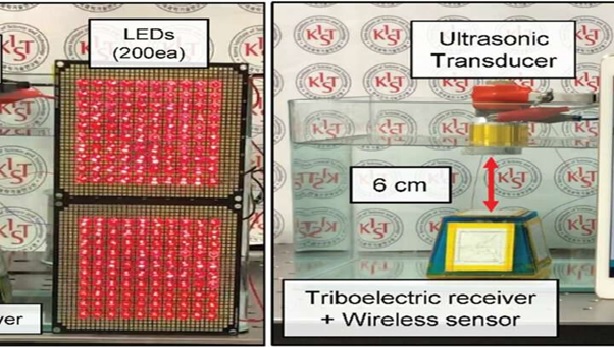Device can be charged using ultrasonic waves
A team at the Korea Institute of Science and Technology (KIST) and a number of Korean universities have unveiled a system for wirelessly powering or recharging implanted electronics and underwater systems safely and efficiently — using an ultrasonic probe.

Figure 1: Ultrasound Energy Could Provide Wireless Power for Underwater Sensors, In-Body Implants
Figure 1 shows that "This study demonstrated that electronic devices can be driven by wireless power charging via ultrasonic waves," explains project lead Hyun-Cheol Song, PhD, of the work. "If the stability and efficiency of the device are further improved in the future, this technology can be applied to supply power wirelessly to implantable sensors or deep-sea sensors, in which replacing batteries is cumbersome." [1]
Electromagnetic (EM) induction and magnetic resonance can be used in wireless energy transfer. EM induction is presently being used in smartphones and wireless earphones; however, its usage is limited because EM waves cannot pass through water or metal, resulting in short charging distance.
Now, brand-new research exhibits how patterned, periodic deformations of a single layer of graphene transforms it into a fabric with digital properties beforehand seen in twisted graphene bilayers. This method additionally hosts extra surprising and fascinating conducting states on the boundary.
In addition, this method cannot be easily used to recharge implanted medical devices as the heat generated during charging is harmful. The magnetic resonance method requires that the resonant frequencies of the magnetic field generator and transmitting device are exactly the same; moreover, a risk of interference with other wireless communication frequencies, such as Wi-Fi and Bluetooth, exists. [3]
Instead of EM waves and magnetic fields, scientists used ultrasonic waves as an energy transmission medium. They developed a model that receives and converts ultrasonic waves into electrical energy. The model works on the triboelectric principle that effectively converts small mechanical vibrations into electrical energy.
The efficiency rate of energy transfer can be improved by adding a ferroelectric material to the triboelectric generator. Doing so, energy transfer efficiency was significantly improved from less than 1% to more than 4%.
Moreover, charging more than 8 mW power at a distance of 6 cm was possible, which was sufficient to operate 200 LEDs simultaneously or to communicate Bluetooth sensor data underwater. [2]
References:
- https://www.hackster.io/news/ultrasound-energy-could-provide-wireless-power-for-underwater-sensors-in-body-implants-913caf3b3bde
- https://www.techexplorist.com/using-ultrasonic-waves-new-charging-technology/46501/
- https://scitechdaily.com/using-ultrasonic-waves-to-charge-underwater-and-body-implanted-electronic-devices/
Cite this article:
Sri Vasagi K (2022), Device can be charged using ultrasonic waves, Anatechmaz, pp. 252

